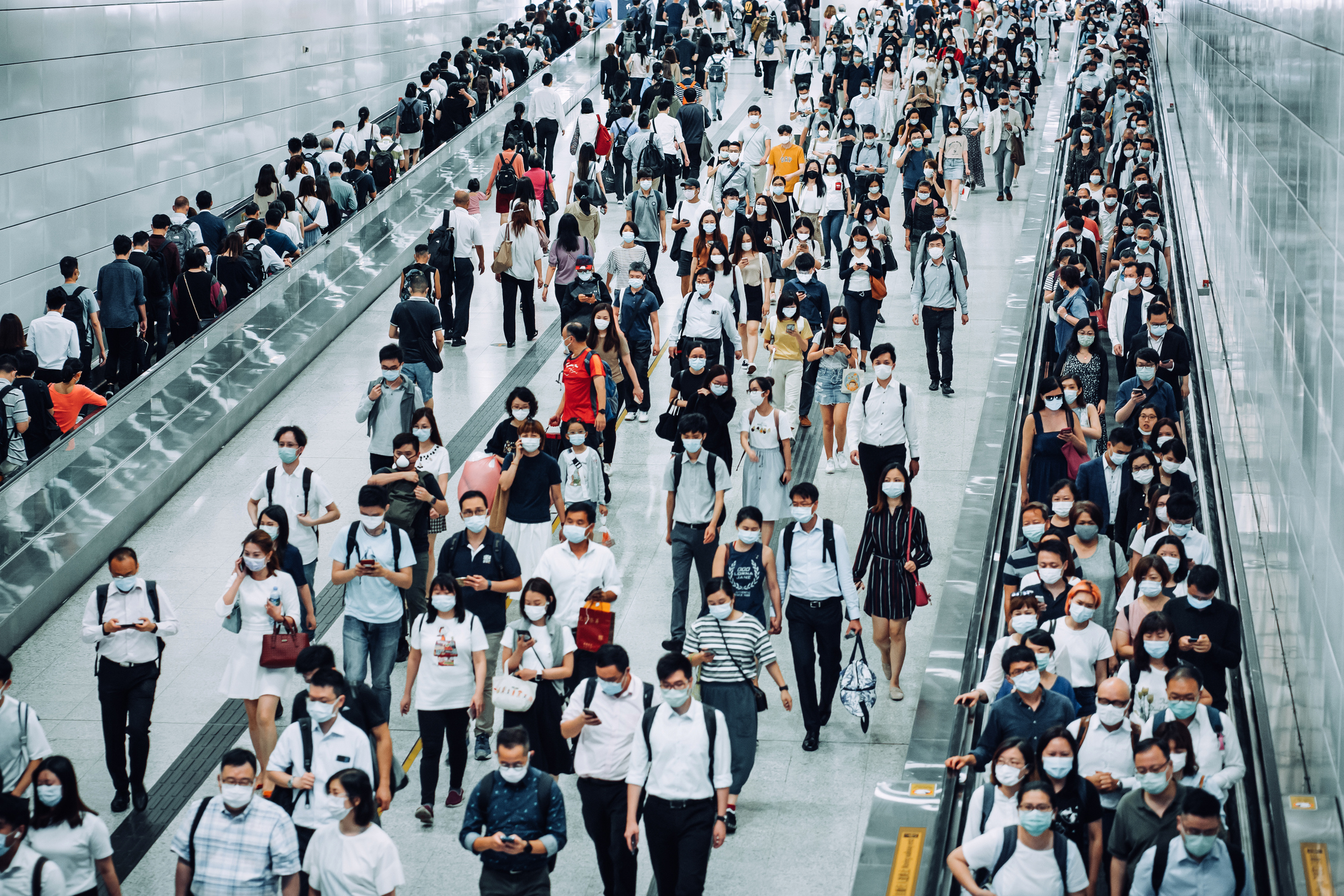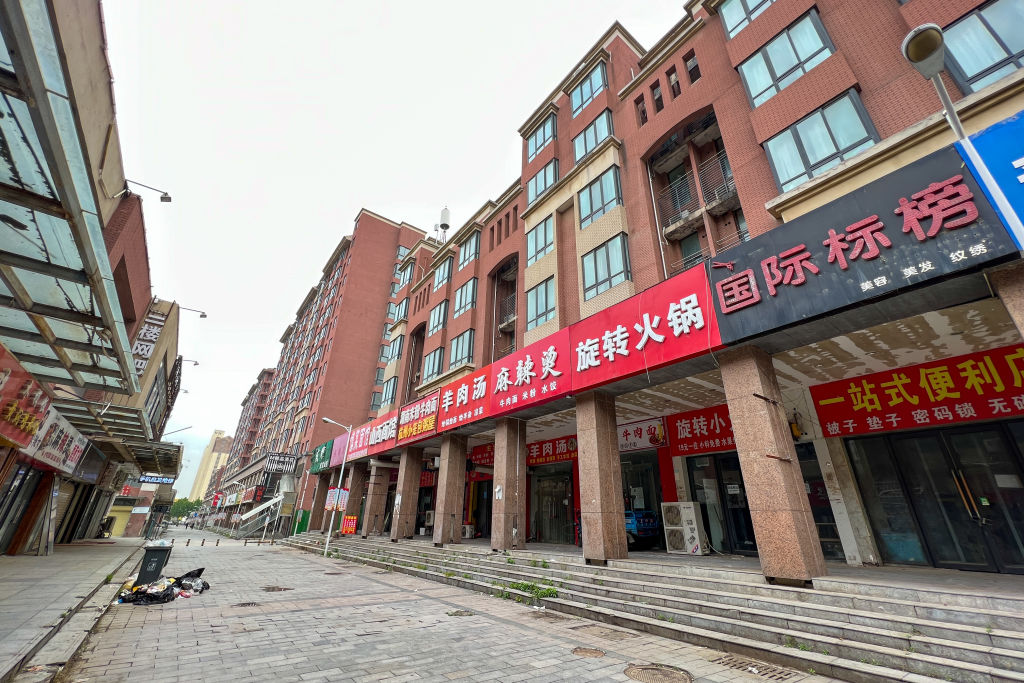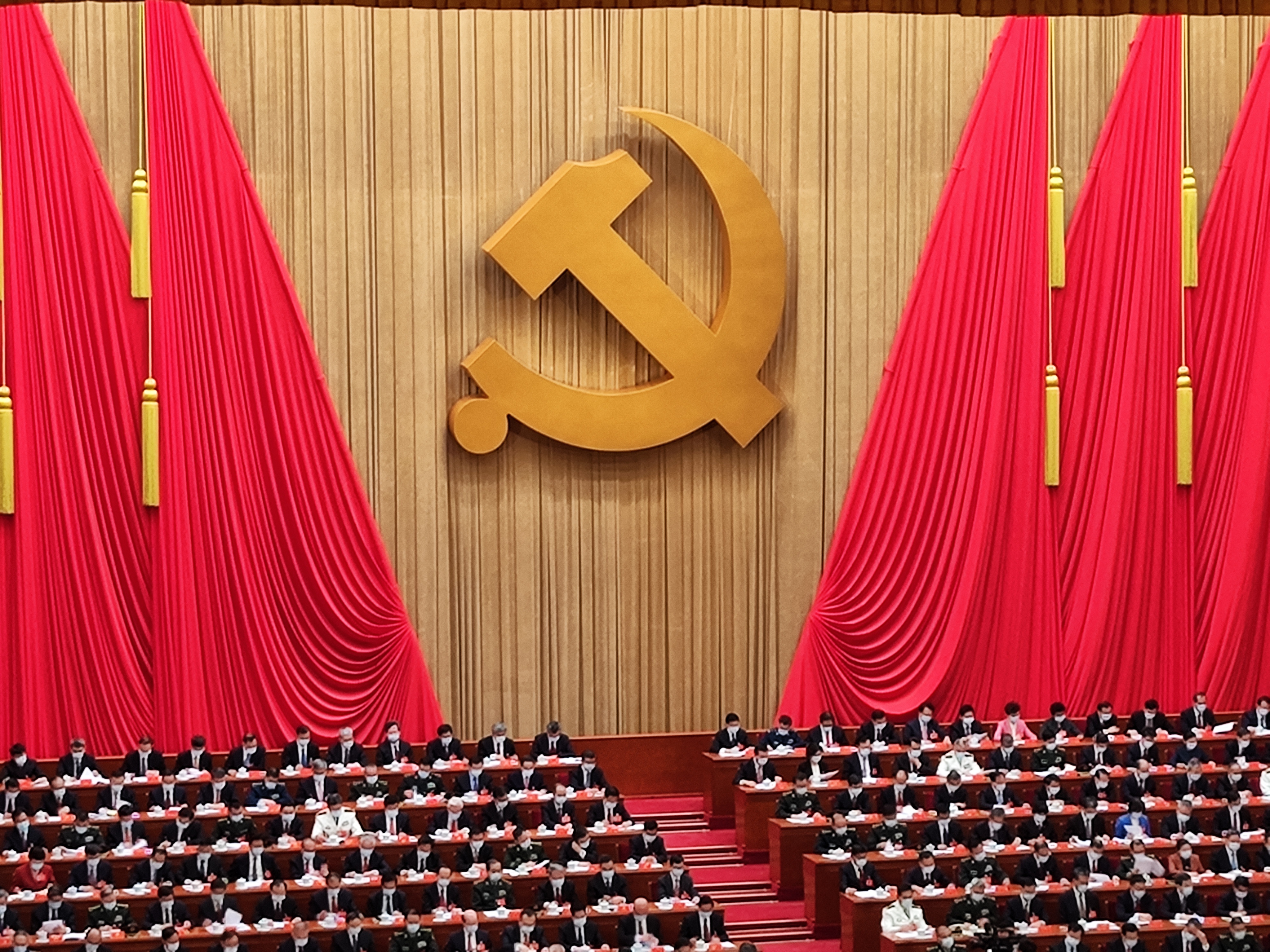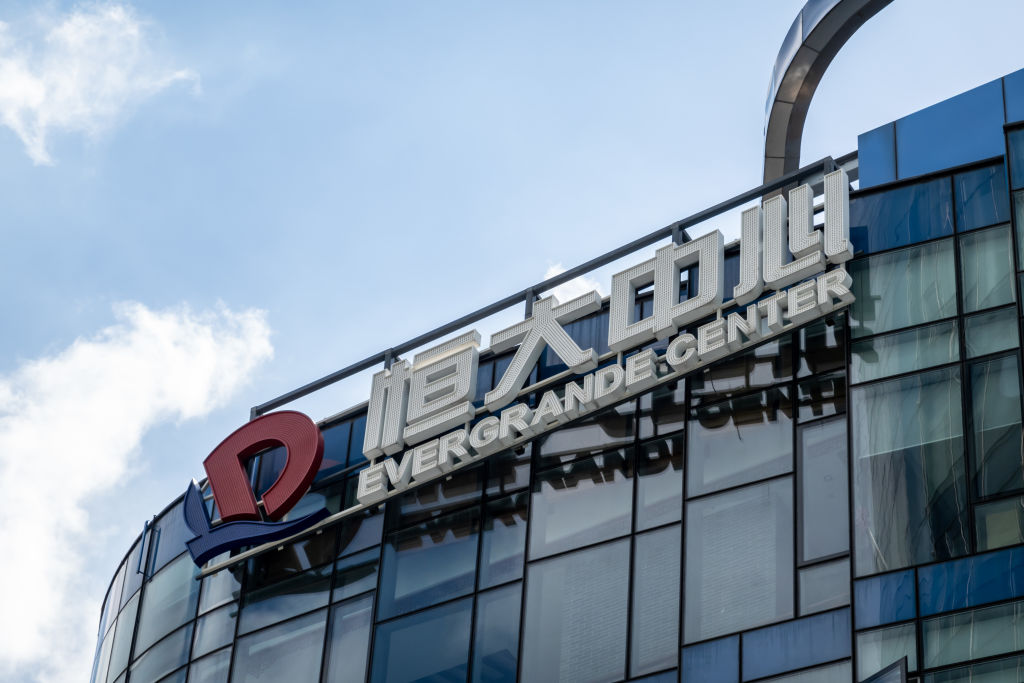
- Others
China’s Economy at the Crossroads: Historic Slowdown Highlights Challenges of New Five-Year Plan
November 28, 2025
Economic affairs topped the agenda of the fourth plenary session of the Chinese Communist Party’s Twentieth Central Committee when it met in Beijing for four days beginning on October 20. The main item of business was deliberation and adoption of recommendations for China’s fifteenth Five-Year Plan. But given the latest economic figures, some of the discussion inevitably focused on short-term pump-priming options. According to macroeconomic data released by the National Bureau of Statistics on the day the conference opened, China’s real gross domestic product rose at an annualized rate of 4.8% in the third quarter, down from 5.2% in the second. Even more concerning, perhaps, was the absence of September data on youth unemployment, which had soared to 18.9% in August.
A Glowing Self-Assessment
The central purpose of the fourth plenum was the discussion of long-term structural issues and deliberation of the next Five-Year Plan. This involved an assessment of the outcome of the current plan, which is now drawing to a close. In its October 20 release, the National Bureau of Statistics included an assessment of China’s progress under the fourteenth plan.
Since 2021, we were told, China has (1) augmented its economic power and global clout, (2) enhanced its technological self-reliance and strength, (3) modernized its industrial structure, (4) improved the balance between urban and rural development, (5) opened up China’s markets further, (6) shifted toward a green economy, (7) strengthened social programs and raised living standards, and (8) boosted economic security with respect to such essentials as food and energy.
The first item, augmenting China’s economic power and international clout, is particularly important to the current regime, since it pertains directly to Xi Jinping’s dream of restoring China’s greatness—the vision around which he has sought to rally the nation. But quantitative assessments like that released by the NBS have little power to reassure the people when they see no sign of improvement in their own lives.
What’s Happening to China’s Economy?
Experts outside of China have long questioned the reliability of Beijing’s macroeconomic statistics. But whatever the actual rate of expansion, the overall trend in the past year has been unmistakable. From an annualized rate of 5.4% in the first quarter, official GDP growth slowed slightly (to 5.2%) in the second period before dropping to a sobering 4.8% in the third. What has caused this slowdown in China’s economic growth?

For several years now, the Chinese economy has been struggling with the combined effects of the pandemic’s aftermath and the real estate industry’s ongoing slump. Since the second half of 2025, moreover, it has been feeling the impact of the tariffs imposed by US President Donald Trump. While the pandemic’s aftereffects and the real estate slump have suppressed domestic demand, the Trump tariffs have reduced demand for Chinese goods abroad. Year-on-year growth in Chinese exports to the United States was minus 33% in August and minus 27% in September. It is true that exports to places like Africa and South America rose substantially during the same period, but the relatively low-value-added goods that the Global South tends to purchase from China cannot make up for the loss of US sales.
Determined to rev up domestic demand, the Chinese government has mobilized fiscal policies to spur investment, while the People’s Bank of China has embarked on a course of quantitative easing (even while keeping its policy interest rates steady). But these expansionary measures have failed to stimulate the economy. The basic problem is that domestic supply far exceeds demand. Under these circumstances, measures to encourage investment only exacerbate the imbalance. Although the central bank is injecting liquidity through quantitative easing, the credit crunch caused by the real estate crisis has left banks reluctant to lend. In this environment, monetary expansion has not led to the hoped-for increase in domestic spending.
All of this is readily apparent if one examines the economic figures in detail. But the NBS glosses over these issues, cherry-picking and spinning the data to suggest that the recovery is on track. Such obfuscation makes it difficult to draft and implement the policies needed to turn things around.
Sizing Up the Latest Five-Year Plans
Earlier, we summarized the Chinese government’s official assessment of the nation’s economic and social progress under the fourteenth Five-Year Plan. In the table below, I offer my own evaluation vis-a-vis the major objectives set forth in the fourteenth plan, along with the goals of the provisional fifteenth plan (based on information published by the National Development and Reform Commission). A circle signals that the goal was fully or largely achieved; a triangle indicates insufficient progress; and an x signifies failure to achieve the stated objective.
Economic Goals of China’s Fourteenth and Fifteenth Five-Year Plans
Fourteenth Five-Year Plan
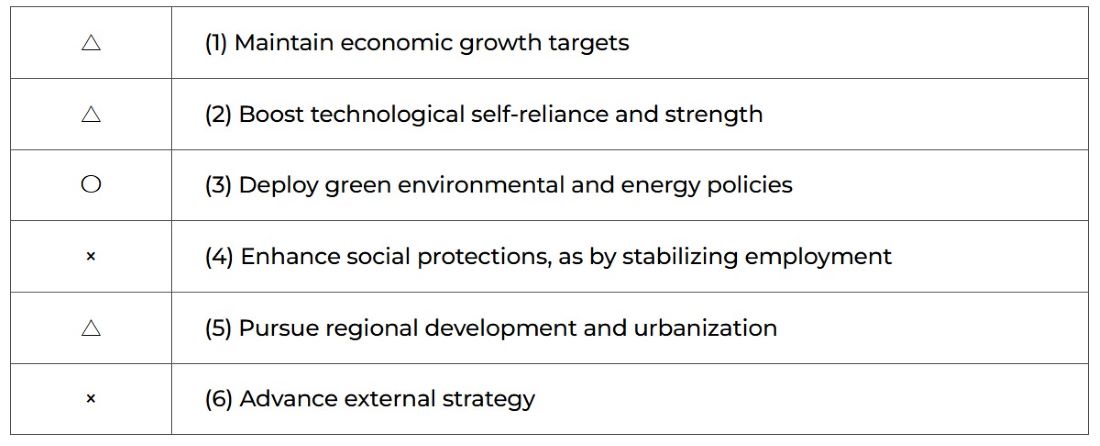
Fifteenth Five-Year Plan (recommendations)

Source: Compiled by the author using materials published by the National Development and Reform Commission.
Economic growth in the period covered by the fourteenth plan was obviously affected by the COVID-19 pandemic, which dragged on for three years, beginning in 2020. This was an unavoidable setback, but the government made things worse with its heavy-handed lockdowns and half-baked post-pandemic stimulus measures—hence the middling grade on economic growth. Likewise, progress toward the goal of building technological self-reliance has been fair at best. The environmental and energy policies of the past five years deserve a high grade for staunching degradation of the environment. On the other hand, efforts to stabilize employment have clearly been a failure. I gave the government a middling assessment on regional development and urbanization, and I gave it a failing grade on its external strategy, given the severe deterioration in China-US relations resulting from Beijing’s shift to “wolf warrior diplomacy.”
Turning to the fifteenth plan, China’s policymakers are to be applauded for emphasizing economic recovery and industrial transformation along with measures to support R&D and technological innovation. The recommendations show an awareness of the need to boost consumption and domestic demand but are deficient in specific policy measures. The goal of further progress toward decarbonization should play to China’s strengths. In terms of integrating development and security, concrete measures are again lacking. With regard to the final goal—supporting rural communities, reducing regional inequality, and boosting incomes—one supposes this to be synonymous with Xi Jinping’s concept of “common prosperity,” which is to say, a more equitable distribution of income. Barring some major change in policy, that objective could remain elusive.
Lingering Distrust of the Markets
The prominent place of industrial transformation in the fifteenth plan speaks to one of the Xi regime’s key economic imperatives going forward. China’s economy hitherto has relied on expansionary fiscal and monetary policies to fuel continued investment and growth. But this has fostered inefficiencies that have rendered the model unsustainable over the long term.
“Xi Jinping thought” and its dream of restoring China to greatness feature prominently in the recommendations for the fifteenth plan. But to pursue the long-term goal of national rejuvenation, the Xi regime must first get the economy moving again, and this means creating an environment in which the market mechanism can function normally. Yet the latest recommendations say nothing about unleashing market forces. Nor do they mention further opening of China’s markets. These omissions are troubling.
China’s declining economic efficiency results from the inefficient allocation of resources in an environment where the market mechanism is unable to function normally. Particularly problematic in this context is the ongoing climate of support for the government’s large stake in industry and top-down control of the economy. The fifteenth Five-Year Plan shows no indication of a change in this posture, and in the absence of such a shift, the prospects for an economic turnaround are in doubt. If Xi Jinping’s government decides to ignore the current slowdown and prioritize long-term goals over the next five years, there is a good possibility that the country’s economic stagnation will deepen.
External and Internal Trials Ahead
The prescription for returning to a growth trajectory is simple: liberalize markets and continue opening up the economy. This will require a commitment to uphold the existing rules of international trade and engagement.
It is worth noting that successful implementation of the fifteenth Five-Year Plan could determine whether Xi Jinping can solidify his power base enough to secure a fourth term. Under earlier plans, the government has emphasized superficial progress, ignoring or glossing over problems lurking beneath the surface. If it takes the same approach during the next planning cycle, mounting resentment over economic inequality could trigger social unrest. The whole point of formulating a Five-Year Plan is to deal with structural issues, not plaster over them. It is time for the Xi regime to confront and root out the irrationality built into China’s economic system.
Finally, a word about Japan-China relations going forward. While economic cooperation with Japan has got to be a high priority for the Xi regime at this critical juncture, Beijing seems wary of dealing with the newly formed right-leaning government of Prime Minister Takaichi Sanae. The big problem here is that the pro-China Kōmeitō’s departure from the ruling coalition has robbed the government of a network of personal and political contacts that helped manage risk in the bilateral relationship. With US-China tensions on the rise, a cooling of Japan-China relations may be difficult to avoid. This is one more headache for the Xi regime at a time of unprecedented challenges at home and abroad.
Originally published on Nippon.com on November 6, 2025, and reprinted here with permission.

